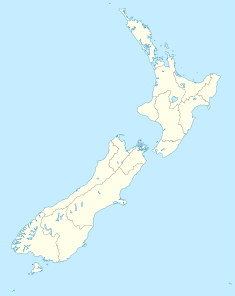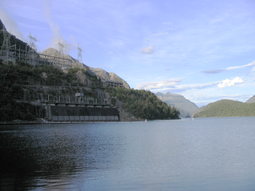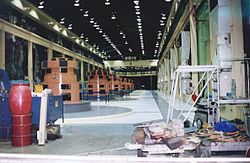- Manapouri Hydroelectric Power Station
-
Manapouri Power Station 
The Manapouri Power Station machine hallLocation of Manapouri Power Station Country New Zealand Location west end of Lake Manapouri, Fiordland National Park, Southland Coordinates 45°31′17″S 167°16′40″E / 45.52139°S 167.27778°ECoordinates: 45°31′17″S 167°16′40″E / 45.52139°S 167.27778°E Status Operational Construction began February 1964 [1] Opening date September 1971 [1] Construction cost NZ$135.5 million (original station)
NZ$200 million (second tailrace tunnel)
NZ$100 million (half-life refurbishment) [1]Owner(s) Meridian Energy Reservoir Creates Lake Manapourib Catchment area 3,302 km2 (1,275 sq mi)[1] Surface area 141.6 km2 (54.7 sq mi)[1] Max. water depth 444 m (1,457 ft) Power station Type Conventional Turbines 7× vertical Francis [1] Installed capacity 850 MW[1] Capacity factor 68.4% / 79.7%c Annual generation 5100 GWh[2] *b Lake Manapouri is a natural lake - the drop between it and the sea is used by Manapouri station.
*^c The former figure is based on the installed capacity of 850 MW, while the latter figure is based on the resource consent limited capacity of 730 MWManapouri Power Station is an underground hydroelectric power station on the western arm of Lake Manapouri in Fiordland National Park, in the South Island of New Zealand. At 850 MW installed capacity (although limited to 730 MW due to resource consent limits[3]), it is the largest hydroelectric power station in New Zealand, and the second largest power station in New Zealand after Huntly.
The western arm of Lake Manapouri is 10 km (6.2 mi) from Deep Cove, a branch of the Doubtful Sound - Manapouri utilises the 230-metre (750 ft) drop between these two to generate electricity. The construction of the station required the excavation of almost 1.4 million tonnes of hard rock to build the machine hall and two 10 km tailrace tunnels.
The power station was built to supply electricity to the Tiwai point aluminium smelter near Bluff, some 160 km (99 mi) to the southeast, which at peak operation consumes 620 MW of electricity. In addition to Tiwai Point, it supplies electricity to the New Zealand national grid, largely supplying the city of Invercargill and the western half of Southland.
Environmental protests by the Save Manapouri Campaign, against the planned raising of lake levels to feed the station, galvanised New Zealanders and were one of the foundations of the New Zealand environmental movement.
Since April 1999, the power station has been owned and operated by state-owned electricity generator Meridian Energy.
Contents
Construction
The power station machine hall was excavated from solid granite rock 200 metres below the level of Lake Manapouri. Two tailrace tunnels take the water that passes through the power station to Deep Cove, a branch of Doubtful Sound, 10 km away. Access to the power station is via a two-kilometre vehicle-access tunnel which spirals down from the surface, or a lift that drops 193 m down from the control room above the lake. There is no road access into the site; a regular boat service ferries power station workers and tourists 35 km across the lake from Pearl Harbour, at the eastern end of the lake.
The original construction of the power station cost NZ$135 million (NZ$1.95 billion in 2008 dollars),[4] involved almost 8 million man hours to construct, and claimed the lives of 16 workers.[1]
Soon after the power station began generating at full capacity in 1972, engineers confirmed a design problem. Greater than anticipated friction between the water and the tailrace tunnel walls meant reduced hydrodynamic head. For 30 years, until 2002, station operators risked flooding the powerhouse if they ran the station at an output greater than 585 MW,(with High lake level and a low tide the station could generate up to 603MW) far short of the designed peak capacity of 700 MW. Construction of a second tailrace tunnel, 10 km long and 10 metres in diameter, finally solved the problem. The increased exit flow also increased the effective head, allowing the turbines to generate more power without using more water.
History
Early history
The first surveyors mapping out this corner of New Zealand noted the potential for hydro generation in the 178-metre drop from the lake to the Tasman Sea at Doubtful Sound. The idea of building a power station was first formulated by Peter Hay, the Superintending Engineer of the Public Works Department, and Lemuel Morris Hancock, the Electrical Engineer and General Superintendent of the Transmission Department of the California Gas and Electric Company during their November 1903 inspection of Lakes Manapouri and Te Anau. Each of the 1904 reports by Hay and Hancock noted the hydraulic potential of the lake systems, being so high above sea level, and while the rugged isolation of the region meant that it would be neither practical nor economic to generate power for domestic consumption, the engineers realised that the location and scale of the project made it uniquely suited to electro-industrial developments such as electro-chemical or electro-metallurgical production.
In January 1926, a Wellington-based syndicate of ten businessmen headed by Joseph Orchiston and Arthur Leigh Hunt, New Zealand Sounds Hydro-Electric Concessions Limited was granted by the government via an Order in Council the rights to develop the waters which discharged into Deep Cove, Doubtful Sound, and the waters of Lake Manapouri, to generate in total some 300,000 horsepower. The company attempted to attract Australian, British and American finance to develop the project, which would have required the construction of a powerhouse and factory complex in Deep Cove, with accommodation for an estimated 2,000 workers and wharf facilities, with the complex producing atmospheric nitrogen in the form of fertiliser and munitions. Various attempts to finance the scheme were not successful, with the water rights lapsing and the company fading into obscurity by the 1950s.
In 1955 the modern history of Manapouri starts, when Harry Evans, a New Zealand geologist with Consolidated Zinc Proprietary Ltd identified a commercial deposit of bauxite in Australia on the west coast of Cape York Peninsula, near Weipa. It turned out to be the largest deposit of bauxite in the world yet discovered. In 1956 The Commonwealth Aluminium Corporation Pty Ltd, later known as Comalco, was formed to develop the bauxite deposits. The company started investigating sources of large quantities of cheap electricity needed to reduce the alumina recovered from the bauxite into aluminium. Comalco settled on Manapouri as that source of power and Bluff as the site of the smelter. The plan was to refine the bauxite to alumina in Queensland, ship the alumina to New Zealand for smelting into metal, then ship it away to market.
Construction history
- February 1963, Bechtel Pacific Corporation won the design and supervision contract.
- July 1963, Utah Construction and Mining Company and two local firms won contracts to construct the tailrace tunnel and Wilmot Pass road. Utah Construction also won the powerhouse contract.
- August 1963, the Wanganella, a former passenger liner, was moored in Doubtful Sound to be used as a hostel for workers building the tailrace tunnel. During the 1930s she was a top-rated trans-Tasman passenger liner, with accommodation for 304 first-class passengers. She continued to serve as a hostel until December 1969.
- February 1964, tailrace-tunnel construction began.
- December 1967, powerhouse construction was completed.
- October 1968, tunnel breakthrough.
- 14 September 1969, the first water flowed through the power station.
- September/October 1969, commissioning of the first four generators.
- August/September 1971, the remaining three generators were commissioned.
- 1972, the station was commissioned. It was then that engineers confirmed the limitations of peak capacity due to excess friction in the tailrace tunnel.
- June 1997, construction work by a Dillingham Construction / Fletcher Construction / Ilbau joint venture began on the second tailrace tunnel.
- 1998, the Robbins tunnel boring machine starts drilling at the Deep Cove end of the tunnel.
- 2001, tunnel breakthrough.
- 2002, the second tunnel was commissioned. A $98 million mid-life refurbishment of the seven generating units begins, with the goal of raising their eventual output to 135 MVA (121.5 MW) each. As of June 2006, four generating units have been upgraded, and the project was on schedule for completion in August 2007.[5]
Political history
- July 1956, the New Zealand Electricity Department announced the possibility of a project using the Manapouri water, an underground power station and underground tailrace tunnel discharging the water at Deep Cove in Doubtful Sound. Five months later, Consolidated Zinc Proprietary Limited formally approached the New Zealand government about acquiring a large amount of electricity for aluminium smelting.
- 19 January 1960, the Labour Government and Consolidated Zinc signed a formal agreement for Consolidated Zinc to build both an aluminium smelter at Tiwai Point and a power station in Manapouri. The agreement violated the National Parks Act, which provided for formal protection of the Park, and required subsequent legislation to validate the development. Consolidated Zinc received exclusive rights to the waters of both Lakes Manapouri and Te Anau for 99 years. Consolidated Zinc planned to build dams that would raise Lake Manapouri by 30 metres, and merge the two lakes. The Save Manapouri Campaign was born, marking the beginning of the modern New Zealand environmental movement.
- 1963, Consolidated Zinc decided it could not afford to build the power station. The New Zealand government takes over. Electricity generated by the plant is sold to Consolidated Zinc at basement prices, with no provision for inflation.
- 1969, Consolidated Zinc's electric power rights were transferred to Comalco Power (NZ) Ltd, a subsidiary of the Australian-based Comalco Industries Pty Ltd.
- 1970, the Save Manapouri petition to the government attracted 264,907 signatures.
- 1972, New Zealand elected a new Labour government.
- 1973, the Prime Minister, Norman Kirk, honoured his party’s election pledge not to raise the levels of the lakes. He created an independent body, the Guardians of Lake Manapouri, Monowai, and Te Anau to oversee management of the lake levels. The six Guardians were all prominent leaders of the Save Manapouri Campaign.
- 1984, the Labour Party returned to power in the general election. The resulting period was tumultuous, with Labour's controversial ministers Roger Douglas and Richard Prebble driving rogernomics, a rapid introduction of "free market" reforms and privatisation of government assets. Many suspected the Manapouri Powerstation would be sold, and Comalco was the obvious buyer.
- 1991, the Save Manapouri Campaign was revived, with many of the same leaders and renamed Power For Our Future. The Campaign opposed selling off the power station to ensure that Comalco did not rehabilitate its plans to raise Lake Manapouri's waters. The Campaign was successful. The government announced that Manapouri would not be sold to Comalco.
- 1 April 1999 - the 1998 reform of the New Zealand electricity sector takes effect: the Electricity Corporation of New Zealand is broken up and Manapouri is transferred to new state-owned generator Meridian Energy.
Specifications and statistics
Power station
Average annual energy output 4800 GW·h Station generating output 850 MW Number of generating units 7 Net head 166 m Maximum tailrace discharge 510 m³/s Turbines 7 × vertical Francis type, 250 rpm, 121.5 MW made by General Electric Canada Generators 7 × 13.8 kV, 121.5 MW / 135 MVA (5648 A), made by Siemens Aktiengesellschaft (Germany). Transformers 7 × 13.8 kV/220 kV, rated at 135 MVA, made by Savigliano (Italy). Civil engineering
Machine hall 111 m length, 18 m width, 34 m height First tailrace tunnel 9817 m, 9.2 m diameter Second tailrace tunnel 9829 m, 10.05 m diameter Road access tunnel 2,042 m, 6.7 m wide Cable shafts 7 × 1.83 m diameter, 239 m deep. Lift shaft 193 m Penstocks 7 × 180 m long Transmission
Two double-circuit (i.e. six-line) 220 kV lines take electricity out of Manapouri switching station to supply Tiwai Point and the national grid. The two lines are:[6][7]
- Manapouri to Tiwai Point Aluminium Smelter, via the North Makarewa sub-station north of Invercargill. (MAN-TWI-A)
- Manapouri to Invercargill sub-station, with one circuit connecting to the North Makarewa sub-station (INV-MAN-A)
Another double-circuit 220 kV line links Invercargill sub-station to Tiwai Point Aluminium Smelter.
References
Bibliography
- Fox, Aaron P.,The Power Game: the development of the Manapouri-Tiwai Point electro-industrial complex, 1904-1969 PhD Thesis, University of Otago, Dunedin, (2001) http://otago.ourarchive.ac.nz/handle/10523/335
- Peat, Neville. Manapouri Saved!: New Zealand’s first great conservation success story: integrating nature conservation with hydro-electric development of Lakes Manapouri and Te Anau, Fiordland National Park Longacre Press, Dunedin (1994)
- Integrating Nature Conservation with Hydro-Electric Development: Conflict Resolution with Lakes Manapouri and Te Anau, Fiordland National Park, New Zealand - Mark, Alan; professor, environmentalist, member of the 'Guardians of Lake Manapouri' institution
- Manapouri - the Toughest Tunnel, a 60-minute television documentary made in 2002 by NHNZ
Notes
- ^ a b c d e f g h "Manapouri Facts and Figures - Meridian Energy". http://www.meridianenergy.co.nz/assets/What-we-do/Our-power-stations/0151MEDManapouriwebPDF.pdf. Retrieved 4 September 2011.
- ^ "List of Generating Stations November 2010 - New Zealand Electricity Authority". http://www.ea.govt.nz/document/11750/download/industry/modelling/long-term-generation-development/list-of-generation-projects/. Retrieved 2011-01-25.
- ^ "Energy Data File". Ministry of Economic Development. 1 July 2010. http://www.med.govt.nz/templates/StandardSummary____15169.aspx.
- ^ "New Zealand CPI Inflation Calculator - Reserve Bank on New Zealand". http://www.rbnz.govt.nz/statistics/0135595.html. Retrieved 2009-03-27.
- ^ "Annual Report 2006" (PDF). Meridian Energy. June 2006. http://www.meridianenergy.co.nz/NR/rdonlyres/05E7CD73-5A1D-4492-99C9-0D1AC66C8D87/0/2006Commentary.pdf. Retrieved 2007-10-04.
- ^ "Otago-Southland Regional Plan - 2010 Annual Planning Report". Transpower New Zealand Limited. http://www.gridnewzealand.co.nz/f3610,29920817/otago-southland-region.pdfhttp://www.gridnewzealand.co.nz/f3610,29920817/otago-southland-region.pdf. Retrieved 1 January 2011.
- ^ "South Island transmission line map". Transpower New Zealand Limited. http://www.gridnewzealand.co.nz/f70,3566/transmission-map-si.pdf. Retrieved 1 January 2011.
External links
- Manapouri power station (Power station info page from Meridian Energy)
Categories:- Fiordland
- Hydroelectric power stations in New Zealand
- Buildings and structures in the Southland Region
- Dam controversies
Wikimedia Foundation. 2010.



